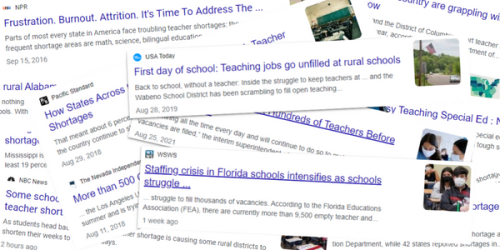“Worth their weight in gold” is how many would describe a great teacher—so what if we paid great teachers their worth? Or at least, paid much higher teacher salaries for those who take on more challenging assignments? That is, more or less, the question that the ACE (Accelerating Campus Excellence) program in Dallas sought to answer.
A new NBER working paper from Andrew Morgan, Minh Nguyen, Eric Hanushek, Ben Ost, and Steven Rivkin tracks the rise (and fall) of the ACE program, and homes in on the importance of bringing highly effective teachers into low-performing schools. The program rests on the foundation of a strong teacher evaluation system, which was implemented in 2013 (disclosure: The superintendent who led the evaluation system reform in Dallas ISD is a former board member of the National Council on Teacher Quality). The district targeted a set of low-performing schools where they would implement the ACE program. The study compares the effects on the low-performing schools that comprise the first two cohorts of the ACE program to a set of comparison schools that were nearly as low-performing (but were not part of ACE).
The ACE program has several components: a signing bonus for teachers ($2,000), annual stipends (ranging from $6,000 to 10,000 for teachers, and more for principals, plus hefty bonuses for counselors and other staff). This pay was coupled with small increases in instructional time, requirements for data-driven instruction, funds for school uniforms, and additional professional development. And importantly, all teachers who previously worked at the low-performing schools identified for the ACE program had to reapply for their positions.
The outcomes were impressive. After the program was implemented, about 80% of teachers at the schools were replaced, and their replacements tended to be much more effective, as indicated by the district’s evaluation system. And, equipped with many more effective teachers than before, the ACE schools saw gains in their students’ reading and math achievement that the researchers labeled “dramatic.” What’s more, students who spent at least a couple years in the ACE elementary schools had greater outcomes when they reached sixth grade as well, especially in math.
But the success did not hold: in 2019, the district ended funding for stipends for schools in the first cohort (reportedly so they could repurpose funds to start a new cohort of ACE schools; as of now there have been four cohorts of ACE schools). The year that the bonuses ended, teachers (especially higher-rated teachers) left the schools at a much higher rates than teachers at the comparison schools (where they were not receiving the ACE incentives). And students’ test scores went back down.
This positive result seems to offer a few lessons. First, it suggests that bonus pay for teachers, likely coupled with other school supports, can draw teachers into low-performing schools. Unlike other less-successful bonus pay efforts like the Teacher Incentive Fund program (TIF), these bonuses were substantial and presumably, well-advertised. Moreover, these teachers can help their students thrive once they enter their new schools, also likely partly due to the more comprehensive approach of the program. This whole program was bolstered by a strong evaluation system that made possible the identification of highly effective teachers. But, a temporary program may yield only temporary results.
More like this

How are school districts using strategic pay to attract and retain teachers where they need them?

What teachers really want: It isn’t just higher salaries



